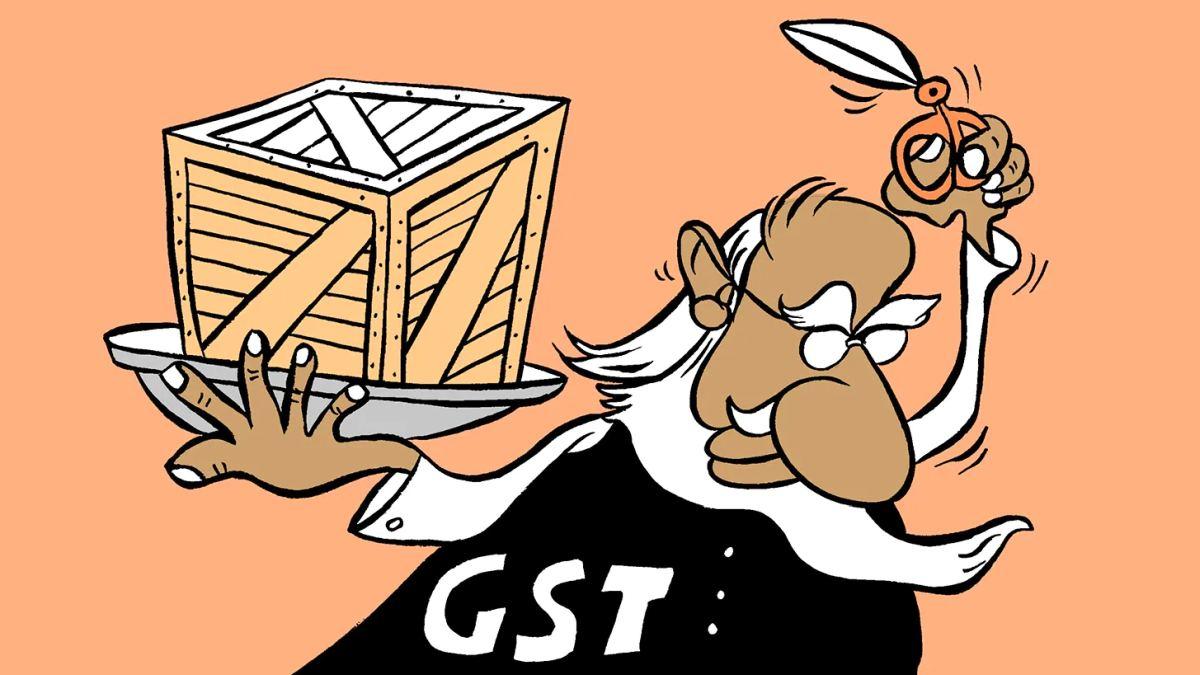Simplifying GST rates, removing exemptions, easing disputes, and speeding up refunds can boost investment in India and offer the best reply to Trump’s tariffs, observes V S Krishnan, former member, Central Board of Indirect Taxes and Customs.

Illustration: Uttam Ghosh/Rediff
There is now a consensus among policymakers that the answer to the Trump tariffs lies not in retaliatory measures but in wide-ranging domestic reforms.
The government has taken up this agenda. Immediately after the Union Budget, a task force on ‘Deregulation’ was set up under Cabinet Secretary T V Somanathan.
In his Independence Day speech, the prime minister announced the creation of a task force on reforms to help India achieve the vision of a ‘Viksit Bharat’ by 2047.
In the same address, he also committed to wide-ranging goods and services tax (GST) reforms by Diwali 2025.
These announcements clearly signal the government’s intent to pursue domestic reforms, but the low-hanging fruit with the potential for maximum short-term impact is GST reform.
The finance ministry is clear in its message that the reforms would be comprehensive, going beyond rate rationalisation. The question is how should the government go about this.
First, the announcement of two GST slabs with special rates for ‘sin’ goods is welcome, but what should the slab rates be? It is suggested that the twin slab rates should not be 5 per cent and 18 per cent, but 8 per cent (the average of the current two merit rates of 5 per cent and 12 per cent) and 18 per cent.
The reason for this is that a higher merit rate would enable the government to integrate GST rate rationalisation with trade policy.
In the trade negotiations, the government is seeking greater market access for products of labour-intensive manufacturing industries like textiles, leather, food processing, and toys.
Logically, these industries must be brought under the merit rate of GST.
At the 5 per cent rate, there would be an accumulation of input tax credit (ITC), especially the utilisation of the integrated goods and services tax (IGST) credits of imported inputs.
At 8 per cent, with reasonable value addition, the accumulation of credit problems would be less pronounced, but how does the government counter the public perception about increasing GST rates?
To resolve this, it is suggested that the government introduce a 1 per cent/2 per cent rate, which could be called the clearing rate or the concessional rate. This will serve a number of purposes.
The government can bring items it does not want to move to 8 per cent from 5 per cent into the lower rate category.
Importantly, the 1 per cent to 2 per cent rate would enable the government to slowly bring the items from exempted categories into duty categories, as exemptions are poison, not panacea, in the GST scheme, which seeks to provide seamless ITC credits across the value chain, from raw materials to retail.
This phasing out of exemptions can be done in two stages. In the first phase, those goods that were exempted by the central government under excise duty in the pre-GST period, but not exempted under state value-added tax (VAT), could be brought under the 1 per cent/2 per cent rate.
Importantly, the fake credit invoice problem would also be addressed, as these fake invoices are generally issued in the name of exempted units.
The final advantage would be that small-scale and micro, small and medium enterprises can avail themselves of credits on the erstwhile exempted inputs so as to reduce the GST liabilities at the output stage.
The abolition of the 28 per cent rate is welcome, as a large number of items like cement and white goods would be brought under the standard 18 per cent rate.
With the compensation cess being merged with the 28 per cent rate, the resulting 40 per cent rate would become applicable to the so-called sin goods like pan masala, aerated waters, high-end cars, and online gaming. Cigarettes can continue to carry a higher rate of duty.
To compensate for the revenue loss, especially on items like cement, the duty on gold and gold jewellery could be merged with the merit rate, as the National Council of Applied Economic Research (NCAER) data suggests that 80 per cent of the purchase and sale of these items is concentrated within the top two income deciles of the population.
The other important area that needs reform is the dispute resolution system. There are far too many demand notices being issued to businesses.
One important reform would be to replace penalties with administrative fines for a number of minor procedural violations.
This list was earlier compiled by the Centre when it introduced service tax. This list would be useful now to decide on the implementation of fees instead of penalties.
In many states like Maharashtra, in the pre-GST period, guidance on levying these fees was based on guidelines issued by the Technical Advisory Committee.
Committees can now be constituted in various states with the membership of both central and state GST officers.
The additional benefit would be forging a fiscal fraternity between central and state GST officers and also promoting the spirit of cooperative federalism.
The introduction of fees instead of penalties would de-clog the dispute resolution system, as these would be decided at a lower level with caps and no appeal provisions.
Recently, the government announced the creation of Principal Tribunal Benches in the states, which will further strengthen the dispute resolution system.
A large number of cases with high courts can now be transferred to tribunals, and one can expect speedier resolution of these cases.
It is also suggested that the government constitute a technical group in the GST Secretariat, which can issue trade advisories based on the decisions of the GST Council on various issues in consultation with the law committee.
Further, the decision of the law committee could be issued as a trade advisory to ensure greater clarity among field officers.
The government also needs to address the problem of delayed refunds. A system of automatic refunds would be desirable, for it would help smaller and medium industries in surmounting working-capital problems.
To begin with, the system can be introduced for exports once it is established that exports have taken place, without insisting on the repatriation of export proceeds, which can be separately handled in coordination with the Reserve Bank of India.
There is also a need to amend the IGST rules to ensure that the IGST state component is distributed horizontally among the states on the Final Destination Principle.
A number of states like Kerala have represented that IGST revenues from ecommerce and other growing etransactions go to the developed states because head offices/regional offices mentioned in the invoices are located in more developed states like Delhi, Haryana, Maharashtra, and Karnataka.
This problem can be solved by mandating that, when addresses of individual consumers are not available, the name of the destination states be mentioned in the einvoice.
Finally, businesses also complain of multiple audits. This issue can be addressed by instituting a system of joint audits by central and state officers in respect of three important sectors, namely telecom, banking and insurance, which have branches in many states.
These single national audits can be done on the basis of audit protocols signed with these companies, with the audits coordinated by audit parties located in the states where the head offices are, where audit-relevant information would be available.
Once an audit is done comprehensively, the units can be relieved of audits for at least three years. It is important that, in these audits, officers with domain knowledge in these sectors are co-opted.
To sum up, these comprehensive GST reforms would send a strong signal to foreign investors that India can be an attractive investment destination. Perhaps, this is the best response to the current trade turbulence.
This column was written before Wednesday’s GST Council meeting.
Feature Presentation: Rajesh Alva/Rediff




